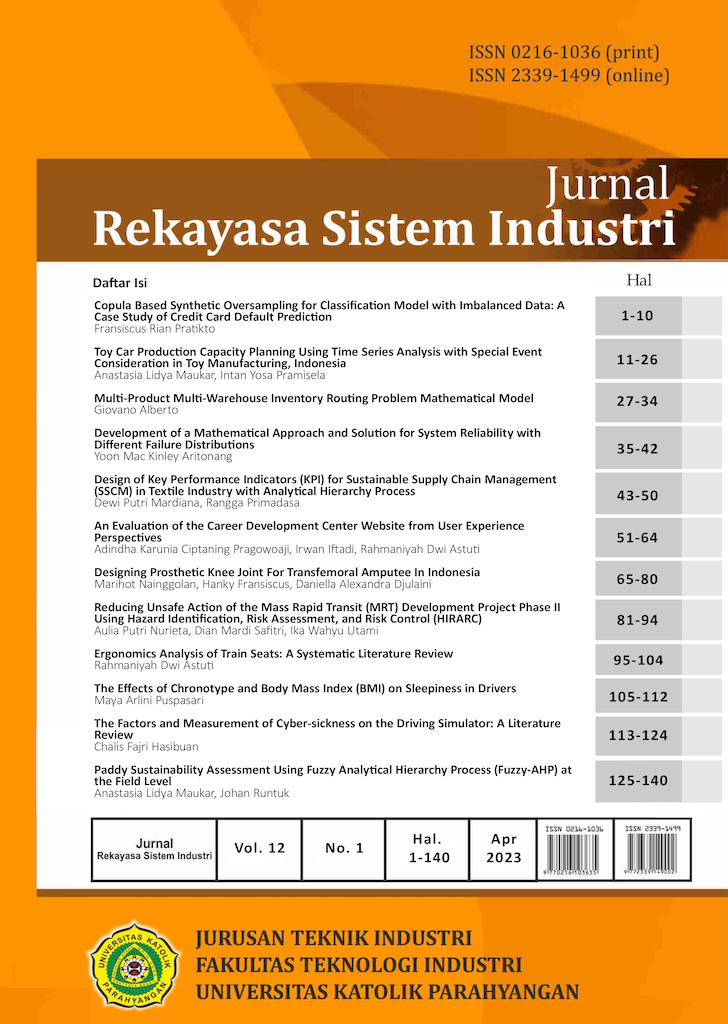Ergonomics Analysis of Train Seats: A Systematic Literature Review
DOI:
https://doi.org/10.26593/jrsi.v12i1.6536.95-104Keywords:
anthropometry, ergonomics, passenger seat, railways, systematic literature reviewAbstract
The train is a popular mode of mass transit for a large number of passengers in Indonesia since it is reasonably priced. However, the existing passenger seats still do not pay attention to anthropometric measurements for Indonesian culture. The UIC standard, which is used as a standard for creating train seats, demonstrates this. Anthropometry is a science that involves measuring the human body and is used to identify variations between people, groups, and other entities. Ergonomic passenger seat design will have a good effect on both the company and the user. This study set out to ascertain the advantages of applying ergonomics to industrial tasks. A thorough literature review of 20 publications and papers published between 2012 and 2022 was done for this study. The results obtained are that there are many industrial activities that apply ergonomics to achieve comfort and the benefits of implementing ergonomics are new design recommendations and design development, knowing the relationship of vibration and energy to comfort, reducing discomfort, activities that affect comfort, the ability to estimate body size, knowing the risks diseases that arise, and knowing the level of importance of ergonomics.
References
Alfeno, S., & Devi, R. E. C. (2017). Implementasi Global Positioning System (GPS) dan Location Based Service (LSB) pada Sistem Informasi Kereta Api untuk Wilayah Jabodetabek. Sisfotek
Global, 7(2), 27–33. https://journal.stmikglobal.ac.id/index.php/sisfotek/article/view/146
Campos, G. H., & Xi, F. J. (2020). Pressure sensing of an aircraft passenger seat with lumbar control. Applied Ergonomics, 84(December 2019), 103006. https://doi.org/10.1016/j.apergo.2019.103006
Chin, K. S., Yang, Q., Chan, C. Y. P., Tsui, K. L., & Li, Y. lai. (2019). Identifying passengers’ needs in cabin interiors of high-speed rails in China using quality function deployment for improving passenger satisfaction. Transportation Research Part A: Policy and Practice, 119(December 2018), 326–342. https://doi.org/10.1016/j.tra.2018.12.004
Cucu, L., Simion, I., Carzola, M., Stoica, G., & Cananau, S. (2016). Ergonomics and accessibility in passenger trains. UPB Scientific Bulletin, Series D: Mechanical Engineering, 78(4).
Dwi Rita Nova, D., & Widiastuti, N. (2019). Pembentukan Karakter Mandiri Anak Melalui Kegiatan Naik Transportasi Umum. Comm-Edu (Community Education Journal), 2(2), 113. https://doi.org/10.22460/comm-edu.v2i2.2515
Groenesteijn, L., Hiemstra-van Mastrigt, S., Gallais, C., Blok, M., Kuijt-Evers, L., & Vink, P. (2014). Activities, postures and comfort perception of train passengers as input for train seat design. Ergonomics, 57(8), 1154–1165. https://doi.org/10.1080/00140139.2014.914577
Gumasing, M. J. J., Zerrudo, M. O. V., & German, J. D. (2019). An ergonomic design of Light Rail Transit (LRT) in the Philippines for persons with special needs. Proceedings of the International Conference on Industrial Engineering and Operations Management, 2019(MAR), 810–818.
Guo, Y. P., Song, G. Q., & Song, F. Y. (2013). The application of the polynomial regression method in high-speed train seat’s curve design. Applied Mechanics and Materials, 380–384, 113–116. https://doi.org/10.4028/www.scientific.net/AMM.380-384.113
Guo, Y., & Song, G. (2014). The high-speed train seat design based on the human lumbar biomechanical analysis. Advances in Mechanical Engineering, 2014. https://doi.org/10.1155/2014/524802
Hapsari, S. N., Sjafrizal, T., & Anugraha, R. A. (2017). Designing Train Passenger Seat by Kansei Engineering in Indonesia. MATEC Web of Conferences, 135. https://doi.org/10.1051/matecconf/201713500017
Marcelino, R., Castro, A., Ferreira, C., & Remelgado, E. (2021). MODSEAT – Innovative Railway Seat Design.
Nadadur, G., & Parkinson, M. B. (2013). The role of anthropometry in designing for sustainability. Ergonomics, 56(3), 422–439. https://doi.org/10.1080/00140139.2012.718801
Prasanthi, G., & Pavani, P. V. (2015). Design and Development of New Passenger Seat for Electrical Multiple Unit Trains. Journal of Multidisciplinary Engineering Science and Technology (JMEST), 2(8), 3159–3199. www.jmest.org
Puspitasari, I., & Koekoeh K W, R. (2016). Modifikasi Kursi Penumpang Kereta Api Ekonomi Yang Ergonomis Dengan Metode Ergonomic Function Deployment. Jurnal Rotor, 9(1), 29–34.
Shifa, S. A., & Kibria, G. (2018). Ergonomic Analysis of Bangladeshi Train Passengers. International Conference on Mechanical, Industrial and Energy Engineering, 1–5.
Singh, L. P. (2012). Investigation of comfort level and passenger seat design (side lower berth) in sleeper class coaches in Indian trains: An exploratory study. International Journal of Manufacturing Technology and Management, 25(1–3), 45–59. https://doi.org/10.1504/IJMTM.2012.047715
Smith, J., Bowler, N., Phillips, S., Conway, H., & Caglar, L. (2019). Development of a Rail Passenger Seat Comfort Specification and Performance Scale. 1–8.
Sugiono, S., Oktavianty, O., Sulistyarini, D. H., Nugroho, W. S., Wiryawan, E., Industri, P. T., & Api, K. (2021). Analysis of Train Passenger Comfort Related to the Vibration and Heat It Creates. Proceedings of the Second Asia Pacific International Conference on Industrial Engineering and Operations Management Surakarta, Indonesia, 3518–3525.
Sugiono, S., Sulistyorini, D. H., Sakinah, N., & Nugroho, W. S. (2022). Re-Designing of Railway Carriages To Increase Ergonomic and Accessible: a Case Studi of Indonesian Railway. Eastern-European Journal of Enterprise Technologies, 4(1–118), 13–22. https://doi.org/10.15587/1729-4061.2022.253415
Suriadi, I., Ketut, I., & Atmika, A. (2017). Studi Kenyamanan Kursi Penumpang Mini Bus Angkutan Pariwisata di Bali dengan Analisis Ergonomic Function Deployment. Prosiding Konferensi Nasional Engineering Perhotelan VIII-2017, 2017, 165–168.
Teo Chuun, B., Darliana, M., & Indah, D. D. D. (2018). Ergonomic design optimization for train seat fit parameters. Malaysian Journal of Public Health Medicine, 18(Specialissue2), 73–78.
Tetteh, S., Bowen-Dodoo, L., & Kwofie, S. K. (2017). Ergonomics assessment of locally fabricated passenger seats in trotro vehicles in Accra, Ghana. Journal of Transport and Health, 6(August 2016), 167–176. https://doi.org/10.1016/j.jth.2017.06.005
Wibowo, R. K. K., Soekarno, S., & Puspitasari, I. (2017). Analysis of Train Passenger Seat Using Ergonomic Function Deployment Method. International Journal of Transport and Vehicle Engineering, 11(10), 1747–1751.
Wibowo, R. K. K., Soekarno, S., Syuhri, A., & Vayendra, D. D. (2018). Analysis and Design of Bus Chair for Economic Class Using Ergonomic Function Deployment (EFD) Method. International Journal of Advances in Scientific Research and Engineering, 4(10), 161–167. https://doi.org/10.31695/ijasre.2018.32921

